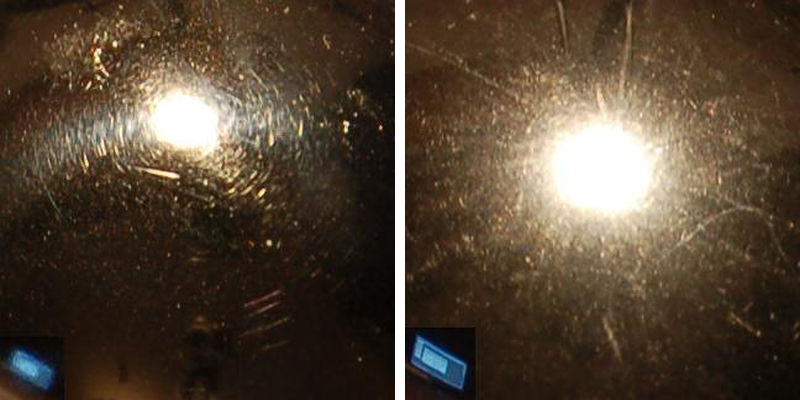
< 3D World
> Intro
• Overview
— 3D World: Mirror Ball, Overview —
Panoramas using Mirror Balls
The topic Panorama discusses elaborate methods, which may give good results. The labour to photograph a complete panorama that even will have to be combined into an HDRI is enormous. It is easier and much faster to photograph the reflection on a mirroring sphere. The speed is bought with a much lower quality result — there is no free lunch. However, for many applications this limitted quality suffices.
Types of Mirror Balls
There are three types of mirror balls: christmas glitter ball or bauble, garden
ornament and ball-bearing ball or chrome steel ball.
The Bauble (picture below, left) is cheap. Usually blown glass and not completely round. Often, there is a drop at the underside; and above there is some means to hang it on a tree. These balls are available in different sizes and colours, are lightweight and a nice sound emanates from them when they fall on the ground and burst. For experimenting purposes, they are good enough. Of course, you will organise colourless ones — plural! —, because wear, or rather tear, will probably be quite generous.
The Garden Ornament (above, centre) is more expensive and sometimes a whole set has to be purchased. Depending on the price, there are also some made of glass or acryl. They all come in different colours. Most of them are made from polished sheet metal. Two sheets are pressed into a form and two hemispheres are soldered or welded together. They are not really round and if they fall down, get dented in a way no tin-smith can unmake. The welding or solder seam is very annoying but this type of ball is nicely suited to experiment with.
The Chrome Steel Ball (picture above, right) is expensive and heavy. Made for a ball bearing you can expect they are round and hard. Nevertheless, they get scars and scratches on the surface if they fall down, and it can badly hurt if your foot inadvertently gets in the way before the ball hits the ground. These balls show fine traces from the polishing. Some exhibit spidery hairlines, others some kind of wide spokes. These reflect very bright light. The best choice but rather hard to come by at the required size.
Surface of Chrome Steel Balls
The fine traces from polishing mentioned are different from manufacturer to manufacturer,
two examples.
- Example 1: Steelball (picture below, left)
Diameter 50 mm (~2"), weight 0.53 kg (1.2 lb), material 1.4401 (AISI 316), part nr. 050000-061X from JSK° Nanoball GmbH, price Euro 75.The polishing marks are sharp, short, very fine and can hardly be seen. These polishing marks seem to be overlaid by a very fine pattern that looks like mist. The computer screen mirrored in the ball which is inset at the lower left corner appears blurred. This ball fell to the ground once and the marks on top left are the result of that mishap.
Example 2: Chrome-Coated-Steelball (picture above, right)
Diameter 2.5" (63.5 mm), tolerance ±0.0002", weight 2.3 lb (1.04 kg), part nr. 9528K72 at McMaster-Carr's, price $ 87.27. The company does not export to private persons and I bought the ball at e-bay's for $ 35.The polishing marks are wide, short, very flat and hardly to be seen. The problem with the mist is not evident here. The mirrored computer screen inset at the lower left corner is sharp. Panorama photographs with this ball are better. Avoid direct light.
-
If panoramas are created for use as HDRI light probes, there is no way avoiding reflections of bright light sources somewhere on the sphere. If the HDRI is rendered as backdrop it ought to be moved in such a way that those bright parts are not visible.
© 2004 - 2018 by Horo Wernli.

